What is dental plaque? What is tartar? And what's the difference between the two? Dental plaque and tartar are related, but they are not the same thing.
That being said, one thing that dental plaque and tartar (calculus) do have in common is that you don't want them staying on your teeth for long. The good news is that it's quite simple to remove plaque at home with a good oral hygiene routine and perhaps some special tooth plaque removal products. Tartar on teeth, however, will require attention from your dentist.
In this article we will go over the following points:
- Dental plaque definition
- What causes plaque buildup up on teeth
- Why you should get rid of dental plaque on teeth
- The difference between dental tartar vs plaque
- How to remove plaque from teeth
We hope this information helps you understand how to take better care of your teeth and prevent oral health problems in the future.
In This Article
What is dental plaque?
A simple dental plaque definition is: a sticky coating that builds up on the teeth and around the gums. A technical term for teeth plaque is “dental biofilm,” since it contains live bacteria and saliva. The gluey texture helps the bacteria stick together around your teeth and gums, where they feed on the carbohydrates left behind when you eat and drink.
Without effective plaque removal, the bacteria breed and the biofilm spreads. As the bacteria feed, they produce acids which erode tooth enamel and harden plaque on teeth, contributing to a number of dental problems including:
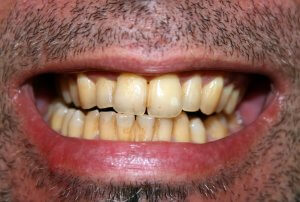

- Tooth decay
- Yellow teeth
- Gum disease
- Bad breath
- Tartar on teeth
- Loss of teeth
This is why it's important to remove plaque from teeth daily, and know how to get rid of plaque on teeth correctly—more on that later.
What causes plaque on teeth and how to prevent it
Dental biofilm naturally occurs in our mouths so there's nothing you can do to get rid of teeth plaque completely or stop it building up every day.
However, the food and drink you consume has a direct effect on the amount of biofilm on your teeth. The bacteria in dental plaque on teeth thrive on carbohydrates (including sugars)—perhaps you've noticed that the sticky film on your teeth is worse after eating candy, chocolate and other sugary foods.
Regular alcohol consumption also upsets the balance of healthy bacteria in your mouth.
Reducing your intake of these foods, or at least limiting them to mealtimes rather than snacking throughout the day, can help minimize the amount of plaque on your teeth. Some foods have been shown to help reduce plaque buildup on teeth, and contribute to better gum health but they are no substitute for brushing and flossing, either with traditional floss or an interdental brush.
Another thing that might help are oral probiotics. They help fight against the bad bacteria in your mouth that can be found in dental plaque. You can read more about it in our full guide. You can also find out about kids' oral probiotics.
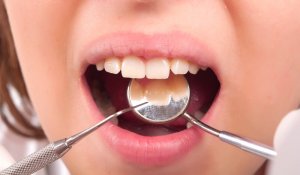

Pregnant women are more likely to develop plaque on their teeth because of hormonal changes in their mouths, so it's important to pay extra attention to oral hygiene during pregnancy, so that plaque buildup on teeth doesn't turn into tartar.
What does plaque look like?
It's hard to see plaque on teeth because it's almost colorless, sometimes pale yellow. You're more likely to feel it by running your tongue along your teeth or scraping your tooth with a fingernail. If you've just eaten or haven't brushed your teeth for a while, chances are you'll be able to feel the parts of your teeth which are furry and not as smooth as when you've just brushed. That's dental plaque.
But what does plaque look like? If you want to see exactly where you have plaque buildup on your teeth, use a dental plaque disclosing tablet. This dyes any dental biofilm and shows you where you need to focus your brushing efforts to get rid of harmful plaque buildup on teeth.
Dental plaque vs tartar
We've given the definition of dental plaque buildup, but what's the difference between plaque vs tartar (also called dental calculus)?
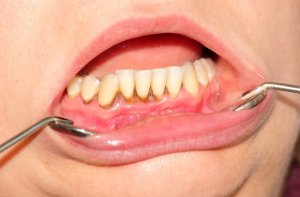

If you don't remove plaque from your teeth properly, it starts to solidify. In just a few hours it can become harder, making it more difficult to brush off. But after several days it absorbs minerals from your saliva and forms a solid substance called tartar. Dental tartar often originates in the gaps between teeth, around the base of teeth, and below the gumline.
Over time, any buildup of tartar on teeth will expand, thicken, and darken in color. It can start to irritate the gums and will eventually lead to gum disease.
Tartar buildup bonds strongly to teeth and is very hard to remove yourself. If you notice white, yellow, brown or black tartar on your teeth—a hard substance which doesn't come off with normal brushing or flossing—you'll need to visit your dentist for a professional teeth cleaning, known as a scale and polish.
The table below summarizes some key differences between plaque and tartar:
Plaque | Tartar/Calculus | |
How quickly does it form? | A few hours after brushing, or right after eating | Plaque hardens into tartar after several days |
Texture | Sticky film | Hard mineral buildup |
Appearance | Colorless or pale yellow, hard to see | Noticeable white, yellow, brown or black substance stuck to teeth |
Removal | Thorough brushing and flossing removes most plaque; regular dental visits advised | Requires professional cleaning at the dentist (scale and polish) |
If left | Hardens into tartar | Expands to cover teeth, contributes to decay, gum disease and more |
If you want to learn more about the differences between plaque vs tartar check out the video below. Dental hygienist Whitney will have you laughing along as you find out some interesting information.
How do you remove plaque from teeth?
The good news is that the best way to remove plaque on teeth on a daily basis is simply by brushing your teeth thoroughly and flossing. But, you do need to make sure you're brushing correctly. You also need to make sure you're spending enough time on keeping your teeth clean, morning and night, to make sure you're breaking down all that plaque buildup on teeth.
Some people find that an electric toothbrush provides more effective dental plaque removal than a manual brush. However, brushing alone isn't effective at removing plaque between teeth, which is why daily flossing is important. If you don't like using regular string floss, an oral irrigator (water flosser) could be a good investment.
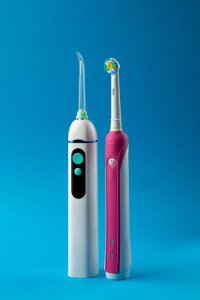

Here are some basic steps for removing dental plaque on teeth before it turns to calculus:
- Brush twice a day—once before bed and one other time—for at least two minutes
- Use a soft-bristled toothbrush and avoid using too much pressure
- Angle the brush at 45 degrees to the tooth to reach below the gumline
- Concentrate on brushing every surface of every tooth
- Floss between teeth before or after brushing
- Don't rinse with water or mouthwash immediately after brushing, because this washes away the ingredients in your toothpaste.
For more information on how to remove plaque on teeth at home with a good oral hygiene routine, we have a separate guide which explains how to brush your teeth properly.
Dental biofilm cannot be removed simply by rinsing with water, although rinsing after you eat can help wash away some of the sugars and acids left behind. You may also use a fluoride mouthwash or chew sugar-free gum to help keep your teeth clean between brushing.
The best way to beat plaque buildup is with a professional dental cleaning. Cleanings should be done at least once every six months to prevent excessive plaque buildup. Depending on your history and susceptibility to disease, however, cleanings might need to be done more frequently. Plaque buildup can lead to unhealthy gums and tooth decay. Most routine dental cleanings only take about 30 minutes, and include scaling and polishing to make sure all plaque is removed and you leave with a fresh, clean smile.
Dr. Ashley Niles, Niles Family Dentistry
Teeth plaque removal tools
If you look online, you'll find a variety of dental plaque scrapers, plaque removal kits, and even electric plaque removers available to buy for removing plaque from teeth. These are generally marketed at people who have tartar on their teeth and want to remove it without visiting the dentist.
There are also ultrasonic tooth cleaners, which use vibrations and water to break up and wash away plaque and tartar. These should be used with caution to remove dental plaque at home. And you should only use one made by a reputable brand. You can find out more about these cleaners in our ultrasonic tooth cleaner review.
Tools like scrapers should not be used at home. That's because trying to use specialist dental tools on your own teeth to remove plaque at home puts you at risk of damaging your teeth and gums. Plus, you'll find it very hard to remove tartar from the back of your teeth and other areas you can't see.
What's the best toothpaste to remove plaque on teeth?
Removing plaque from teeth has more to do with your toothbrushing routine and technique than what kind of toothbrush you have. If you are brushing correctly and using floss to clean between your teeth, this should be enough to keep tooth plaque at bay regardless of the toothpaste you use. However, there are certain toothpaste ingredients which can help neutralize acid in your mouth, so you could look for a plaque removal toothpaste or tartar control toothpaste containing one or more of these:
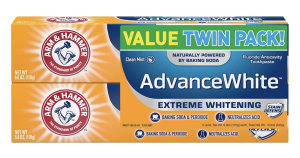

- Baking soda (sodium bicarbonate): The alkalinity of baking soda helps balance out the acidity of dental biofilm. Its abrasiveness can also help get dental plaque off teeth. Arm & Hammer is one popular toothpaste brand that uses this ingredient to fight gum disease.
- Sodium pyrophosphate: Regular use of a toothpaste containing this ingredient can hinder dental plaque formation.
- Triclosan: This antibacterial agent fights the bacteria that live in teeth plaque.
- Zinc citrate: This ingredient has been proven to reduce the viability of dental plaque bacteria for up to 12 hours after brushing.
There are many dental plaque-fighting and tartar control toothpastes available, so the best toothpaste for dental plaque buildup in your case may come down to personal preference and taste. Read our full best toothpaste guide to learn more. You can also read about specific toothpastes like AP 24 in our review here.
Mouthwash for dental plaque removal
Mouthwash can contain certain ingredients which help reduce bacteria and protect teeth from plaque buildup, in particular fluoride and cetylpyridinium chloride. However, using mouthwash in itself isn't a very effective way of removing plaque on teeth, or preventing plaque formation, and it certainly shouldn't replace brushing and flossing.
How to remove hard plaque
Hardened tooth plaque buildup on teeth, known as tartar or calculus, can only be removed by a dentist or hygienist. The dental procedure, called tooth scaling, uses specialist tools to dislodge the cement-like plaque formation that's stuck to your teeth.
Plaque removal from dentures
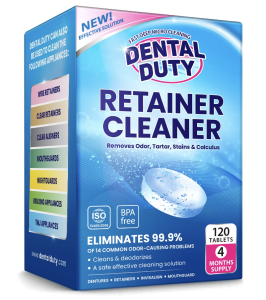

The Oral Health Foundation advises brushing and soaking your dentures daily to keep your false teeth plaque-free. Special denture cleaning tablets like Dental Duty help remove bacteria and keep dentures feeling smooth and clean. However, dental plaque can build up on dentures—just as it does on natural teeth—if they are not cleaned properly.
Read our dentures article for detailed information on how to clean dentures, including some natural methods to stop plaque formation.
Conclusion
Unfortunately there is no way to get rid of dental plaque permanently. It's always forming in your mouth because of the microbes naturally present there, although foods high in sugar and other carbohydrates can make it accumulate faster.
But how do you get rid of plaque when you need to? The answer lies in your oral hygiene routine.
It's important to practice good oral hygiene daily to remove dental plaque on teeth, otherwise, it can harden into tartar, which can only be removed by a dental professional. Leaving dental biofilm or tartar on teeth contributes to decay, gum disease and bad breath.
Brush twice daily and floss once a day to minimize dental plaque buildup on your teeth. Also have regular dental checkups so your dentist can catch any problems early and show you which areas to work on.
FAQs
How do you remove plaque from your teeth at home?
If you're wondering how to get rid of plaque on teeth, you're in for some relatively good news. The best way to remove plaque from teeth at home is by brushing and flossing regularly. You may be tempted to purchase fancy dental tools that you've seen your dentist or hygienist use, but it is not safe to use these tools at home.
What's the difference between plaque and tartar?
The main difference is that plaque comes first. If left alone it turns into tartar. Plaque can be removed at home by a toothbrush, but tartar is much harder and must be removed by a dentist or hygienist. It's important to not let plaque turn into tartar, because tartar can lead to tooth decay and gum disease.
What is plaque made of?
Plaque is a sticky material that coats your teeth and is made of food particles and saliva. Bacteria feed on the food particles in your plaque, and they can lead to gum disease and tooth decay. That's why it's important to brush and floss regularly.
How does plaque lead to tooth decay?
Bacteria live in the plaque on your tooth and produce acids that wear down tooth enamel. This bacteria also can cause your gum tissue and bone to become infected, and that's what leads to tooth decay.
What is the best toothpaste for plaque?
Most commercial toothpastes have plaque-fighting qualities, but the best toothpastes for plaque have fluoride and baking soda. If your plaque has turned to tartar, you may need a deep cleaning.
How does plaque form?
Leftover food particles on your teeth provide bacteria a place to grow, and the saliva in your mouth mixes with the bacteria and food particles, resulting in that fuzzy, slimy coating we know as plaque. Although a little bit of plaque is formed every time after you eat and in itself is not the problem, plaque buildup can lead to tooth decay and should be hindered by regular brushing and flossing.
ADA.org: Baking soda dentrifices and oral health. Consulted 7 October 2019.
NCBI: The effect of a toothpaste containing 2% zinc citrate and 0.3% Triclosan on bacterial viability and plaque growth in vivo compared to a toothpaste containing 0.3% Triclosan and 2% copolymer. Consulted 7 October 2019.
NCBI: Dental plaque biofilm in oral health and disease. Consulted 7 October 2019.




